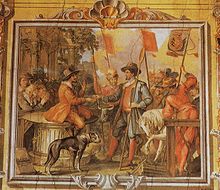Carinthian installation of dukes
The Carinthian Duke establishment was the ceremony of the enthronement of the ruler of the Duchy of Carinthia . The duchy had existed since 976 and came into the possession of the House of Habsburg and Habsburg-Lothringen in 1335 , where it remained until 1918.
Ceremony and story

The installation of the duke consisted of three parts:
- Appointment on the Fürstenstein in Karnburg ( in Windisch speech , i.e. in Slovenian )
- Church consecration in the Cathedral of Maria Saal
- Homage and fiefdom at the Herzogstuhl on the Zollfeld
A detailed report for this three-part ceremony is available from Abbot Johann von Viktring . He described the installation of Count Meinhard II of Görz-Tirol as Duke of Carinthia in 1286; the count was a partisan of King Rudolf von Habsburg and was enfeoffed not only with Carinthia but also with Carniola . Another mention from the year 1308 or 1309 can be found in the rhyming chronicle of the chronicler Ottokar from the Gaal .
The prince stone, the upturned base of a Roman column from the time of the province of Noricum , was already used in the Principality of Carantania for the ritual institution of the Slavic princes residing in the Karnburg . A farmer checked the candidate, who was also dressed as a farmer, for his suitability as ruler, and only then was he taken to the cathedral and the duke's chair to pay homage. The Herzogstuhl, a stone double throne on the Zollfeld, is documented as early as 1161. But since the late 10th century, the feudal counterpart to the Fürstenstein had been enfeoffed by the new duke, with a representative from the empire being present as a controlling body.
On July 2, 1335, Otto the Happy was the first Habsburg to undergo the Carinthian installation ceremony on the Duke's Chair in Karnburg.
Ernst der Eiserne was the last to perform the ritual on the Fürstenstein on March 18, 1414 in Slovenian . Some rulers still paid homage to the duke's chair until 1651, although some of them were no longer personally present. The homage procedure at Zollfeld was finally replaced by a ceremony in the coat of arms hall of the country house in Klagenfurt .
Today the Fürstenstein can be visited there, the Herzogstuhl is still on the Zollfeld near the main road.
literature
- Wilhelm Deuer: The installation of the Carinthian Duke on the Fürstenstein. In: Ostarrîchi - Austria 996-1996. People, myths, milestones. Catalog of the Austrian national exhibition in Neuhofen an der Ybbs and St. Pölten. Edited by Ernst Bruckmüller and Peter Urbanitsch . Catalog of the Lower Austrian State Museum. NF 388. Berger, Horn 1996. XXIV, 736. 4 °. Object no .: 6.1.05, p. 145. ( online , uni-klu.ac.at; history picture and description of the ceremony)
- B. Grafenauer: Ustoličevanje koroških vojvod in država karantanskih Slovencev. [The establishment of the Carinthian duke and the state of the Carantan Slavs]. Ljubljana 1952
- The Carinthian Herzogstuhl in the course of history. In: W. Neumann: Building blocks for the history of Carinthia. Commemoration for Wilhelm Neumann on his 70th birthday (= Das Kärntner Landesarchiv 12, Klagenfurt ²1994) pp. 15–23.
- A. Ogris: Fürstenstein and Herzogstuhl - symbols of the Carinthian regional history in the conflict of ethnic and territorial tendencies in Slovenian historiography, journalism and politics. In: Carinthia I 183, 1993, 729ff.
- P. Puntschart: Duke installation and homage in Carinthia. A constitutional and cultural-historical contribution. Leipzig 1899
- M. Wutte: The coats of arms in the coat of arms rooms of the Landhaus zu Klagenfurt and in the coat of arms books of the Carinthian State Archives. In: Carinthia I 127, 1937, pp. 109-146.
Web links
- Entry on the establishment of a duke in the Austria Forum (in the AEIOU Austria Lexicon )
- Wappensaal: Fürstenstein , further information from the Carinthian State Museum

